 A couple of weeks ago my main wildlife lens died. It was splashed with too much sports drink and stopped at F22 forever. I did my best to try to repair it but after nearly completely disabling it, I found that the aperture was probably too fragile to clean. At the time it was really bad for me. I had no idea I was about to open up the power of the best of serious lenses. So the lens was shot--and cheaper to buy a new one then to have it fixed or close enough. So instead of adding it to my junk pile I used it to build a system I would find to be the next level past anything I have ever done--and I had one of my greatest days in my history of “build- your own" stuff. I have long told you about the fact I build my own lenses. Much knowledge allowed me to build an adapter that can catch a fly at five feet away almost as optically clear as the one above. The days of extreme crops are over! The adapter I build puts me in a new league and my pro-macro kit for my Pentax got a new life in digital. Check this out. And don't forget to click on them to see a bigger sharper shot. It is soon going to be winter.
A couple of weeks ago my main wildlife lens died. It was splashed with too much sports drink and stopped at F22 forever. I did my best to try to repair it but after nearly completely disabling it, I found that the aperture was probably too fragile to clean. At the time it was really bad for me. I had no idea I was about to open up the power of the best of serious lenses. So the lens was shot--and cheaper to buy a new one then to have it fixed or close enough. So instead of adding it to my junk pile I used it to build a system I would find to be the next level past anything I have ever done--and I had one of my greatest days in my history of “build- your own" stuff. I have long told you about the fact I build my own lenses. Much knowledge allowed me to build an adapter that can catch a fly at five feet away almost as optically clear as the one above. The days of extreme crops are over! The adapter I build puts me in a new league and my pro-macro kit for my Pentax got a new life in digital. Check this out. And don't forget to click on them to see a bigger sharper shot. It is soon going to be winter.THERE IS NO COMMERCIAL "PHOENIX" ADAPTER! YOU CANT BUY IT!
I BUILT THE THING!
I got several emails and comments from people who did not read the text and assumed I'd bought this rig. READ the texts. Most of the pictures on my site were taken with unconventional home brew optical systems I put together completely myself and added to existing cameras or lenses. I still have a lot of practice needed on this rig. It will take continued testing to learn how to use the adapter and hold some of the heavy lenses and rigs it needs. I invented and called the "Phoenix" because it used the mount that was for the wildlife lens that broke. From the ashes of a disaster arose a whole new set of abilities! Now I'm glad that expensive lens broke because I would have never invented this lens without this situation and it may have been years before I could afford to get lenses like this or break a lens by accident and discover it. I invented this system and know it can be done again. These first few shots--are not much and only slightly show what is possible. This thing has the power to take very extreme macro shots and depth of field chances far higher then f22. Like Earthquakes, one stop over f22 is multiplied mathematically. By the time you reach f30 you can't even take a picture on the most sunny of days without very long exposures and or iso numbers pushing way past 1600.
 "Fall is not falling yet"
"Fall is not falling yet"Generally, if I see something I like, I take a picture of it--even if I have to keep switching lenses. Although this sequence of pictures is supposed to be about the incredible adapter I built, I thought I'd add some more "normal" shots.
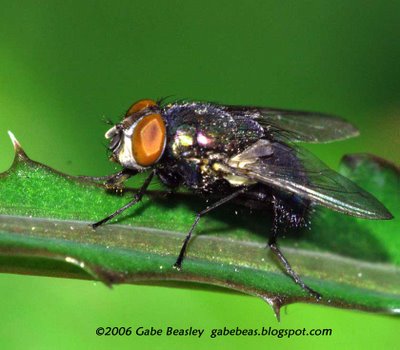 This fly made me say "I won't ever swat a fly again" when I captured it's image from over a foot away making it easy. I wish there were more insects here in The Dalles to photograph. Flies are not any particular special interest to me and I've swatted a few in my time--but there are tons of them out here in The Dalles and I have done two many bee shots. I can't wait for my trip to Guam where I may be able to finally for fill a childhood dream of taking tropical pictures of spiders and insects.
This fly made me say "I won't ever swat a fly again" when I captured it's image from over a foot away making it easy. I wish there were more insects here in The Dalles to photograph. Flies are not any particular special interest to me and I've swatted a few in my time--but there are tons of them out here in The Dalles and I have done two many bee shots. I can't wait for my trip to Guam where I may be able to finally for fill a childhood dream of taking tropical pictures of spiders and insects. It does not rain often here, so when it does the camera comes out with the sun quick, even if I'm having a bad day. Finally I am registered enough with local police department that I can walk around without being stopped. I've got to say I am glad the cops are suspicious. I am glad people are vigilant. My first digital camera and laptop was stolen and it took me years to recover. My business cards are my badge to walk around taking pictures. Remember to take ID if you do--many people may be suspicious of you and call the police. Just be decent and honest and you will be fine. I've been questioned a half dozen times or so for walking around with a big camera in residential areas.
It does not rain often here, so when it does the camera comes out with the sun quick, even if I'm having a bad day. Finally I am registered enough with local police department that I can walk around without being stopped. I've got to say I am glad the cops are suspicious. I am glad people are vigilant. My first digital camera and laptop was stolen and it took me years to recover. My business cards are my badge to walk around taking pictures. Remember to take ID if you do--many people may be suspicious of you and call the police. Just be decent and honest and you will be fine. I've been questioned a half dozen times or so for walking around with a big camera in residential areas. Out of focus water droplets suggest the presents of "spirit orbs" or Ghosts, in this picture. You know--being a photographer I really get a kick out of those people who think an out of focus peace of dust is there long dead great grandpa or something. Why the heck would he look like that? I am undecided on most supernatural subjects but with a background in electronics and photography I notice allot of this stuff. Some of it is definitely bunk. Some of the best UFO shots were hub caps thrown in the air and a nice quick sunny snapshot.
Out of focus water droplets suggest the presents of "spirit orbs" or Ghosts, in this picture. You know--being a photographer I really get a kick out of those people who think an out of focus peace of dust is there long dead great grandpa or something. Why the heck would he look like that? I am undecided on most supernatural subjects but with a background in electronics and photography I notice allot of this stuff. Some of it is definitely bunk. Some of the best UFO shots were hub caps thrown in the air and a nice quick sunny snapshot.
My digital SLR is supposed to be comparable to a medium format studio-style film camera. It is a bit better then a very expensive 120 film camera. According to some photographers. I am able to do landscapes like this only with a lot of room. Wide angles can be done several ways. This shot was possible with just my main lens at a wide angle most of all because of the distances here. This is the Columbia river. This panorama is actually a crop. I could not put the whole small town on the picture because I took this quick. However details can be made out in the full-version but unfortunately I also cannot put the full-res version on my website. Just one full size picture would take up much more space on line then all these shots on this post combined.
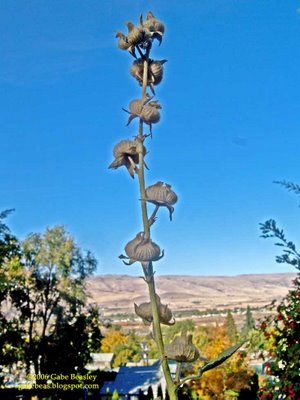 Notice how this photo at least to me seems to imitate really old color film. I have several books that talk about early color processing. I fell for it by accident. I wanted the buds to be visible. Your looking at Washington state in the background. This is a real natural shot--the buds were not inserted as it might look and the angle I had to hold my camera at was very painful after a while. Nobody usually knows how much us photographers--amateur or pro--go through to bring you this pictures! You got to have a quick mind and a be willing to get in lots of pain, close calls, and very quick nerves and more to get your shot--AND protect your gear. If a car drives by while your changing lenses--you might need to send your camera in to be cleaned! These days taking good pictures is easy and common. Feeling like you can and should call yourself a Photographer is not. It takes more then a camera and a few good pictures. That's how my humble self sees it. Taking pictures often involves holding a heavy camera for a long time. However with my condition (Pancreitius and the pain it causes) I have learned that I can do it well and it is a very possible thing for me to do since I got out of the hospital. No heavy lifting--I am glad I was not really into stuff like sports.
Notice how this photo at least to me seems to imitate really old color film. I have several books that talk about early color processing. I fell for it by accident. I wanted the buds to be visible. Your looking at Washington state in the background. This is a real natural shot--the buds were not inserted as it might look and the angle I had to hold my camera at was very painful after a while. Nobody usually knows how much us photographers--amateur or pro--go through to bring you this pictures! You got to have a quick mind and a be willing to get in lots of pain, close calls, and very quick nerves and more to get your shot--AND protect your gear. If a car drives by while your changing lenses--you might need to send your camera in to be cleaned! These days taking good pictures is easy and common. Feeling like you can and should call yourself a Photographer is not. It takes more then a camera and a few good pictures. That's how my humble self sees it. Taking pictures often involves holding a heavy camera for a long time. However with my condition (Pancreitius and the pain it causes) I have learned that I can do it well and it is a very possible thing for me to do since I got out of the hospital. No heavy lifting--I am glad I was not really into stuff like sports. This is another kind of photography pain. Knowing what might happen to your subject. I really hope they don't blast this building. The Dalles has a rich history but all I see is our country attitude (like none of those automatic checkout machines and stuff) is going away. Google is moving in to town. I only like that for one reason--more jobs is good. I took this shot while waiting for a Greyhound bus so I never went over and looked at it more. I'm not sure what it is but I have a guess since it's on the old rail road it might be some kind of old rail station. I kept the highway in the picture rather then crop--to show how times have changed.
This is another kind of photography pain. Knowing what might happen to your subject. I really hope they don't blast this building. The Dalles has a rich history but all I see is our country attitude (like none of those automatic checkout machines and stuff) is going away. Google is moving in to town. I only like that for one reason--more jobs is good. I took this shot while waiting for a Greyhound bus so I never went over and looked at it more. I'm not sure what it is but I have a guess since it's on the old rail road it might be some kind of old rail station. I kept the highway in the picture rather then crop--to show how times have changed.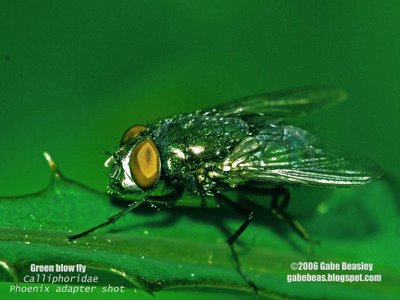 This is a green blow fly. It is possible in the full version to see the fungus growing on the hairs with my gear. I can't change lenses fast enough for every shot--but this one I got several versions of showing how flies feed--something I will probably post later.
This is a green blow fly. It is possible in the full version to see the fungus growing on the hairs with my gear. I can't change lenses fast enough for every shot--but this one I got several versions of showing how flies feed--something I will probably post later. This grumpy looking jumper is deceptively small--it's a baby. When full grown it will be about twice it's size (about 7-10mm). The adapter I have lets me take pictures from distances that are great. Usually more then one foot away. Using the one of my adapters I could have shot this from five feet away--but that is deceptively nice. Trying to find a tiny spider from that distance and keeping the camera stable is nearly impossible. So it's not usually practical or useful. I have several distances--one to two feet depending on the subject is the usual. Before I invented this adapter system I was only able to shoot the regular 6-7 inches away. Most simple macro photography is capable of no further and many lenses are built for that.
This grumpy looking jumper is deceptively small--it's a baby. When full grown it will be about twice it's size (about 7-10mm). The adapter I have lets me take pictures from distances that are great. Usually more then one foot away. Using the one of my adapters I could have shot this from five feet away--but that is deceptively nice. Trying to find a tiny spider from that distance and keeping the camera stable is nearly impossible. So it's not usually practical or useful. I have several distances--one to two feet depending on the subject is the usual. Before I invented this adapter system I was only able to shoot the regular 6-7 inches away. Most simple macro photography is capable of no further and many lenses are built for that. This is a carpenter ant. Click on it for a larger view--Don't forget--to get back to my
This is a carpenter ant. Click on it for a larger view--Don't forget--to get back to myWebsite click your back arrow button.
HOW A FLY THAT LOOKS LIKE A BEE CLEANS IT'S WINGS
 I saw this fly land and shot it from about one and a half feet away. I got in to about one foot and got a higher shot to capture it's cleaning techniques.
I saw this fly land and shot it from about one and a half feet away. I got in to about one foot and got a higher shot to capture it's cleaning techniques. First one wing, now the other.
First one wing, now the other.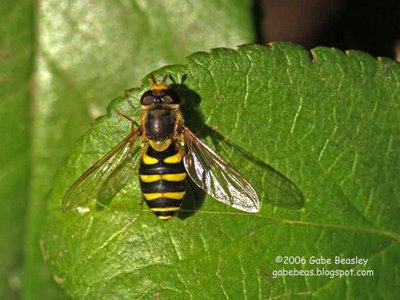 And then you got one clean fly. This is a hover-fly often called a "bee fly" because it looks like a bee. It has however no sting, and bares these colors to have the confidence of a bee or hornet.
And then you got one clean fly. This is a hover-fly often called a "bee fly" because it looks like a bee. It has however no sting, and bares these colors to have the confidence of a bee or hornet. I can hit f32-34 with one of my macro lenses. But usually I have to stick to something more lower since I don't have a massive flashgun. In the future these pictures will improve as I get better at using my gear. And better gear. The adapter requires me to both operate my digital SLR and set the f-stop on the lens I am using manually.
I can hit f32-34 with one of my macro lenses. But usually I have to stick to something more lower since I don't have a massive flashgun. In the future these pictures will improve as I get better at using my gear. And better gear. The adapter requires me to both operate my digital SLR and set the f-stop on the lens I am using manually.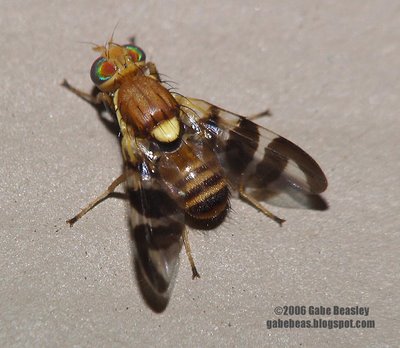 Here is another tiny insect for my digital insect collection. In this case a strangely colored fly. It is only about 6-8mm. Having over a foot of distance between you and the subject is a serious advantage I thought I could only get on film before I built my adapter for the E-500 SLR. I could have shot this fly from four feet away with the addition of another lens and tripod. It is incredible to have this much distance. I could never afford the kinds of lenses to do this on by budget. Being able to do this without 1000s and 1000s of dollars takes a lot of thinking outside the box. Don't ever take anything for granted and take good care of your gear. One splash of a sports drink could wreak vital electronics or other stuff. Even the most expensive cameras and lenses can be destroyed by being careless.
Here is another tiny insect for my digital insect collection. In this case a strangely colored fly. It is only about 6-8mm. Having over a foot of distance between you and the subject is a serious advantage I thought I could only get on film before I built my adapter for the E-500 SLR. I could have shot this fly from four feet away with the addition of another lens and tripod. It is incredible to have this much distance. I could never afford the kinds of lenses to do this on by budget. Being able to do this without 1000s and 1000s of dollars takes a lot of thinking outside the box. Don't ever take anything for granted and take good care of your gear. One splash of a sports drink could wreak vital electronics or other stuff. Even the most expensive cameras and lenses can be destroyed by being careless. This scruffy looking housefly was just one of a few things I found today. There are the occasional beetles, but the intricate parts of a fly make for a very good test subject for my lens adapter and the lenses I use for it. It will freeze here soon. This guy looks dead, but he's not. I freed him from an old spider web. After seeing how complex flies really are, I have a new respect for them. I wish we had tons of other interesting insects here--but I take what I can get.
This scruffy looking housefly was just one of a few things I found today. There are the occasional beetles, but the intricate parts of a fly make for a very good test subject for my lens adapter and the lenses I use for it. It will freeze here soon. This guy looks dead, but he's not. I freed him from an old spider web. After seeing how complex flies really are, I have a new respect for them. I wish we had tons of other interesting insects here--but I take what I can get.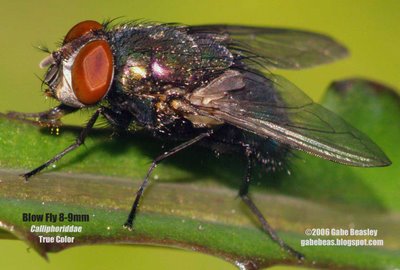
ONLY SLIGHTLY CROPPED TO SHOW DETAIL
Another shot of that fly I found. This time taken a bit closer. It was on a briar and the background is green because the light is very defused. Interestingly, at such a high macro the foliage is completely invisible and a green nearly artificial looking background is all that is left. Pushing macro shots even further is possible with a better flash or flashgun. I have the gear to capture serious depth of field I just need to get a better flash among tons of other items. Here it is feeding organ extended partly. The organ is surrounded in sensory hairs, it is called a proboscis and hangs just above the branch under the head. I can't put massive files up here--so unless you buy a CD from me this is all I can show you. I convert my pictures to JPEG for storage and backup. A tip everybody should know.
The other day I saw a Quadra 840 A/V In it’s day the most powerful consumer computer in the world. Arguably. It was about $6000 or so. I can’t remember exactly. This was in a small Mac store that no longer exists in Beaverton. I’ll never forget the girl working there trying to teach it to recognize speech. like “open folder” and stuff. I really liked it, but as usual I had to go for a laptop and my dad sure did not have a budget for that! I saw it, and about everything you would want for it--at the local thrift store the other day for about 10 bucks. That is just creepy. This shows how much and how fast technology changes and how digital photos if they are to be preserved must be put on mediums that can be quickly adapted to future technologies. Now days I exclusively use external hard drives so that I can simply copy over to the next level of technology when it comes up. USB 2.0, 3.0 and above--and whatever comes after that there will always be a way to store and copy over. If you don't keep up however, an old CD or DVD may be unreadable just 30 years from now. A good argument for taking some pictures on film. The chemicals and gear are too simple to be lost to technological advancement.
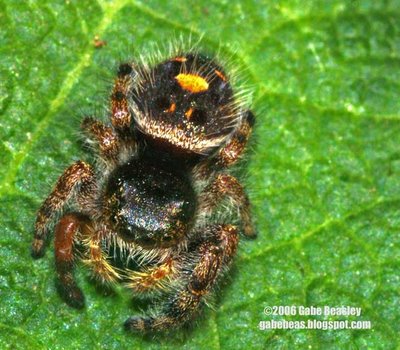
So here she is again--I can't get over that look. I think this is a lady here. As I watched her she did some tricks. Jumping spiders can be fun to play with when they watch you. If you can catch them in the moment. And you should remember, I'm operating a manual f-stop control here. It's mechanical. I could probably never use the servo power line from the camera to operate a solenoid or something to operate apertures of my non-digital Pentax lenses. I would not even try because of dangers to the camera. So I have to site and focus--hold it as steady as possible--clamp down into a dark view and shoot half blind. It works. I am actually taking less pictures now because that distance between me and the subject gives me time, they don't run or respond fast and I don't have to torture myself sneaking up on something as often. Just like an old manual camera--and it works fine. With a distance that works now it's well worth it. I took one of these shots standing. If I had used my old lenses this little jumper would have jumped a long ways away really fast. Another missed shot at the illusive baby jumpers. She will grow up to be very black and white. Young like this-I finally got the shot I wanted.

As she was leaving, interested in my camera gear--she looked back almost to say goodbye.
 I was so far away from her in my first shot that she did not seem to notice me. When she did she looked up and here it is--I did not have time to turn the switch on to get a higher F-stop so I got this with a shallow but just by luck, good depth of field. That's it for now--there is more to come and tons of pictures to post all winter if I have the energy and time.
I was so far away from her in my first shot that she did not seem to notice me. When she did she looked up and here it is--I did not have time to turn the switch on to get a higher F-stop so I got this with a shallow but just by luck, good depth of field. That's it for now--there is more to come and tons of pictures to post all winter if I have the energy and time.
No comments:
Post a Comment